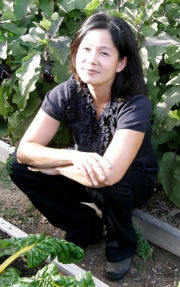On Tuesday, the summer solstice marks the official start of a new season. While the warm weather is great for fruit and berries, leafy greens don’t fare as well and will soon begin to bolt. Sorrel, a tangy herbaceous green, is a particularly nutritious, and it’s just at the end of its season.
Dr. Pamela Yee, along with her husband, Dr. Charles Paolino, runs Hook Mountain Growers in Nyack, N.Y. She grows sorrel and explains why it’s an important plant for farmers and gardeners.
“It acts as what’s called a dynamic accumulator, [which means it] sends down roots further than most plants go — into the subsoil,” she said. “Sorrel is known to collect calcium phosphorous and potassium, bring it up into the roots and into the leaves.”
In addition to being healthy for consumption, the leaves make for excellent compost. Letting sorrel decompose is one means of organically reintroducing minerals to soil. 
Sorrel, which is a perennial like calendula and anise hyssop, is a plant that’s considered to be part of the “permaculture” movement. The concept was created in the 1970s by two Australians and has its roots in long-term sustainable agriculture. Sorrel fits into the permaculture idea because it serves more than one purpose: It’s both edible and contributes to the soil around it.
“Sorrel is very easy to grow,” said Yee (pictured right). “Once you put it in the ground, it takes a year to establish, and it’s really the second year where you start getting a better harvest.”
She added that after three or four years, the plant becomes so large that it should be divided and given more space — or divided and gifted to other gardeners.
In terms of nutrition, sorrel is high in vitamins A and C.
“In the distant past, it was actually used to prevent scurvy when citrus was not available,” said Yee.
On the other hand, Yee, who specializes in holistic medicine and has a practice in Manhattan, notes that sorrel contains a high amount of oxalic acid.
“Oxalic acid can actually bind calcium in gastro-intestinal tract, making it a problem for certain people with a common type of kidney stone — [but] that’s really in high amounts,” she said, adding that both spinach and rhubarb also contain the same property.
The acid is what gives sorrel its green-apple and lemon-like flavor. Since it’s so tart, Yee said that people aren’t likely to overeat the green.
Traditionally, sorrel is used in French soups and in sauces to accompany seafood. Below, try out Yee’s recipe for Potato, Leek and Sorrel Soup.
Potato, Leek and Sorrel Soup
Serves 4-6
- 2 Tbs Butter
- 3 Large or 6 Medium Leeks, white parts only, finely chopped
- 1.5 lbs boiling potato, quarted and thinly sliced. You may leave the skins on if potatoes are organic.
- 2-4 handfuls of sorrel leaves, stems removed
- Salt and pepper
- 7 cups of water
Heat butter in a wide soup pan and add leeks and potatoes, cooking over low heat covered for 10 minutes. Add 7 cups of water and 1.5 tsp of salt and bring to boil. Reduce to a simmer, partially covered, until the potatoes become very soft to the point of breaking apart, about 35-40 minutes. In the last 10 minutes, add the sorrel to the pot. Press a few of the potatoes against the side of the pan to break them up and give the soup some body. Season to taste with salt and pepper and serve. Optional: top with creme fraiche or snipped chives.